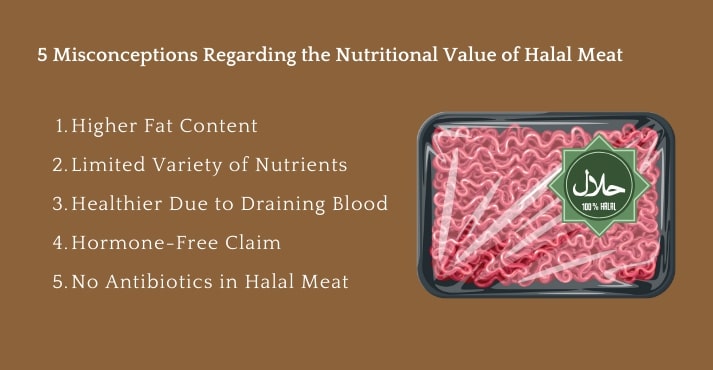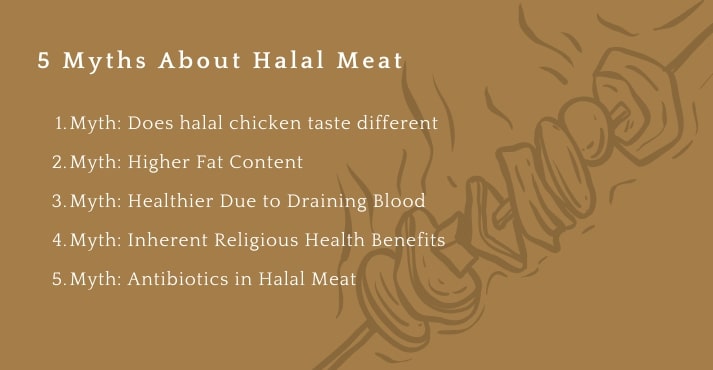Halal meat is reared—and slaughtered—differently from regular meat.
Halal meat is prepared following specific Islamic dietary laws, including a humane slaughter method. It ensures that cows, sheep, and other permissible animals are fed, raised, slaughtered, and prepared for consumption.
The taste of meat can be down to personal preference. But why does halal meat taste different than regular meat?
Understanding Halal Meat

The term “Halal” translates to “permissible” in Arabic. The religious practices that govern the preparation of Halal meat are outlined in Islamic dietary laws.
These include specific guidelines on the slaughtering process, ensuring that the animal is slaughtered by a Muslim who is of sound mind, pronouncing the name of Allah (God) during the slaughter, and using a sharp knife to cut the throat, among other requirements swiftly.
The blood must be drained from the carcass, and the meat should not come into contact with certain prohibited substances.
What meat is considered halal?
- Beef
- Lamb
- Chicken
- Fish
- Venison
- Game birds
According to Statista, the global halal food market is worth over US$2 trillion and is estimated to grow to US$2.8 trillion in the coming years.
Halal certification assures consumers that the food and beverages comply with Islamic dietary laws, giving them confidence in the product’s compliance with religious principles. Certification enhances market access for businesses as it taps into a growing global Muslim consumer base.
Globally, the Muslim population is forecast to grow at about twice the rate of the non-Muslim population over the next two decades. There are over 1.8 billion Muslim people in the world.
Impact of Halal Slaughter on Meat Taste
Halal slaughter involves specific methods adhering to Islamic dietary laws. Here is an overview of the critical steps in the Halal slaughter process:
1. Intention and Pronouncement
The person performing the slaughter must be a Muslim of sound mind. Before the slaughter, the person must express a clear intention to perform the act for the sake of Allah.
2. Sharp Knife
A sharp knife is required to ensure a swift and humane cut. The knife should be free from defects or imperfections that could cause undue suffering to the animal.
3. Slaughtering Technique
The animal should be placed on its left side facing Mecca. The person performing the slaughter should recite the name of Allah (God) before cutting. The cut should be swift and precise, severing the trachea, esophagus, carotid arteries, and jugular veins.
4, Draining of Blood
The blood must be drained from the carcass as much as possible. This is typically done by allowing the blood to flow out after the throat is cut, ensuring the meat is Halal.
But how does the slaughter process create a different halal meat taste than regular meat?
The impact of the Halal slaughter process on the taste and benefits of halal meat compared to other methods is a subject of subjective perception.
While the religious and ethical aspects of Halal slaughter are the primary considerations, some argue that certain aspects of the process affect the taste of the meat.
The draining of blood, an essential aspect of Halal slaughter, is believed by some to contribute to a cleaner and lighter taste. Removing blood is thought to eliminate potential gaminess or off-flavors associated with blood in meat.
Moreover, the humane treatment and swift, precise cuts in Halal slaughter may result in lower stress levels for the animal compared to some conventional slaughter methods. Some people believe reduced stress can positively influence the taste and tenderness of meat.
According to a research study, the most frequent problems caused by stress in cattle are weight loss, carcass injuries, and alteration of meat quality, mainly due to an increase in pH (>5.8), affecting meat tenderness and color (dark meat).
Also, the absence of pre-slaughter stunning may lead to a more natural release of endorphins, impacting the taste and quality of the meat.
Personal preferences, cultural influences, and individual perceptions determine whether or not halal meat is better. It’s important to note that the perceived impact on taste is subjective and can vary among individuals.
Nutritional Value of Halal Meat
Along with being disease-free, the meat retains its nutritional benefits. Nutritional value is another crucial difference between halal meat and regular meat.
- Halal meat offers rich protein.
- Halal meat has vitamins (B12, niacin) and minerals (iron, zinc)
- Halal meat provides amino acids for body functions
- Halal meat is low in additives and preservatives
- Lean halal meats have reduced saturated fats
Misconceptions Regarding the Nutritional Value of Halal Meat

Here are some of the most common misconceptions regarding the nutritional value of Halal meat.
1. Higher Fat Content
The nutritional content of Halal meat is not inherently higher in fat. The fat content primarily depends on factors such as the animal’s breed, diet, and processing methods rather than the Halal slaughter process.
2. Limited Variety of Nutrients
Halal meat provides a similar range of nutrients as non-Halal meat. The nutritional value is influenced by the type of animal, its diet, and other environmental factors rather than the Halal status.
3. Healthier Due to Draining Blood
While Halal meat involves thorough blood drainage, this process doesn’t necessarily make it healthier. Nutritional value depends on various factors, and draining blood primarily adheres to religious practices rather than direct health benefits.
4. Hormone-Free Claim
Halal and non-Halal meats may be subject to similar regulations regarding the use of hormones. The Halal status relates to the slaughtering process and doesn’t guarantee the absence of hormones.
5. No Antibiotics in Halal Meat
The Halal status doesn’t determine antibiotic use. The presence or absence of antibiotics depends on the specific farming and processing practices that can be applied to Halal and non-Halal meat.
How Can You Tell if Meat is Halal?

Halal is challenging to verify because odor, texture, or taste cannot determine whether the food is halal. Therefore, consumers depend on certification and labeling to assess whether food products are produced using halal practices.
According to a research study, organic meat contains 43% Omega 3 polyunsaturated fatty acids known to reduce inflammation, protecting against cardiovascular diseases or neurotic declines.
To determine if meat is Halal, you can consider the following methods:
1. Halal Certification
Look for Halal certification labels from reputable Islamic organizations. These certifications ensure that the meat has been processed according to Islamic dietary laws.
2. Labeling and Packaging
Check the product labeling and packaging for indications that the meat is Halal. Manufacturers often specify the Halal status on the packaging.
3. Butcher’s Information
If purchasing meat from a butcher, inquire about the source and Halal status of the meat. A reputable Halal butcher should be able to provide information about the slaughtering process.
4. Online Resources
Utilize online databases or resources provided by Halal certification bodies to verify the Halal status of specific products or brands.
5. Ask the Supplier or Seller
Directly ask the supplier or seller about the Halal status of the meat. They should be transparent about the sourcing and processing methods.
6. Restaurant Certification
When dining out, look for restaurants that display Halal certification or inquire about sourcing meat from the staff.
7. Community Recommendations
Seek recommendations from the local Muslim community or online forums where individuals may share information about Halal sources.
8. Check for Halal Symbols
Look for symbols like the “Halal” logo or Arabic writing indicating that the product is certified as Halal.
It’s important to note that the reliability of Halal status may vary, and consumers should be vigilant in ensuring that the meat they purchase aligns with their dietary and religious requirements. Halal certification provides a standardized way to verify the Halal status of meat products.
Debunking Myths About Halal Meat

While Halal food is specially made to cater to the community’s needs, it is becoming a popular food option for Muslim and non-Muslim communities. Still, when it comes to halal meat, many myths and misconceptions prevent people from experiencing the great food.
Here are a few of the myths debunked for halal meat vs regular meat.
Myth 1: Does halal chicken taste different
So, does halal meat taste different? No empirical evidence supports the myth that halal chicken tastes different; instead, taste can be subjective and influenced by various factors, including personal preferences, cooking methods, and cultural backgrounds.
However, from a purely scientific standpoint, there is no inherent difference in taste between Halal chicken and non-Halal chicken. Both types of chicken are derived from the same bird species and undergo similar processing methods post-slaughter.
Myth 2: Higher Fat Content
A research study to compare halal and non-halal slaughtering on the quality characteristics of broiler chicken burgers indicated that the fat content of burgers prepared from halal and nonhalal meat was 2.18% and 3.31%, respectively. Therefore, halal meat doesn’t have a higher fat content than regular meat.
Myth: Healthier Due to Draining Blood
According to a research study, the beating of the heart helps to drain the blood out of an animal’s body quickly and thoroughly.
If bleeding is delayed, the heart will stop working due to the lack of oxygen, and blood will not be drained out of the animal’s body, which is a requirement of Halal slaughter. Hence, the myth that meat is healthier due to draining blood has been debunked.
Myth 3: Inherent Religious Health Benefits
The religious significance of Halal slaughter is primarily about the method of slaughter and following Islamic principles rather than a claim of inherent health benefits.
While the humane treatment of animals and the emphasis on cleanliness in Halal practices align with broader principles of health and hygiene, it’s essential to recognize that the nutritional value of meat is influenced by various factors, including the animal’s breed, diet, and processing methods.
Myth 4: Antibiotics in Halal Meat
Halal meat is becoming an exciting choice, independent of religious beliefs. However, little is known about its nutritional content and possible health effects.
A comparative analysis research study was conducted to analyze the physical-chemical and nutritional properties of halal and non-halal meats (beef and lamb). The results indicated that organic and halal meat is produced from grass-fed animals, not treated with antibiotics or growth hormones.
Does Halal Meat Taste Different (FAQs)
Why does halal meat smell different?
Halal meat may have a different smell due to the specific method of slaughter, which involves cutting the throat to ensure a quick and humane death, allowing thorough blood drainage.
Also, the animals are raised following Islamic dietary guidelines, affecting their diet and treatment and influencing the aroma of the meat.
Is halal meat pink?
Halal meat can be pink, similar to non-halal meat, as factors like the age, breed, and diet of the animal primarily determine the color. The pink color is mainly due to myoglobin, a protein in muscle tissues.
Is Halal meat less toxic?
Halal meat, in and of itself, is not inherently less toxic than non-halal meat. The safety and toxicity of meat depend on various factors, including the hygiene and quality control measures implemented during meat production.
While halal certification ensures compliance with specific Islamic dietary laws, it doesn’t directly address the presence of toxins.
Is halal meat healthier?
Halal meat is better for your health. The animal’s diet, living conditions, and processing methods determine its nutritional profile. The healthiness of halal meat is due to the lean protein content, essential nutrients, and absence of harmful substances.
Conclusion
Halal meat products are a growing market segment in the Food and Beverage industry. Meat consumption levels are increasing in many countries, including Muslim and Non-Muslim communities, with essential health and environmental sustainability implications.
While some evidence suggests that Halal meat tastes different from non-Halal meat, there are also myths associated with it. From a scientific standpoint, Halal meat undergoes processing methods similar to non-Halal meat post-slaughter, and both types are derived from the same species of animals.
So, the answer to whether halal meat tastes different lies in any perceived differences in taste, which are more likely due to factors such as the animal’s breed, diet, freshness, cooking techniques, seasoning, and individual preferences.
Therefore, whether Halal meat tastes different from regular meat depends on experiences and preferences rather than inherent differences in the Halal status of the meat.
Moreover, as Halal food makes inroads toward the mainstream, many food manufacturers are exhibiting at F&B trade shows, increasing awareness about the products.





























